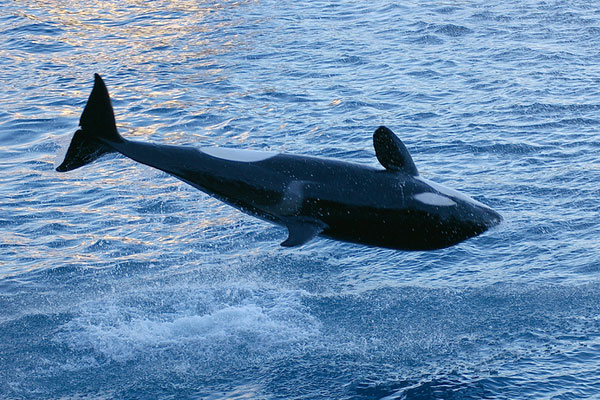Killer Whale or Orca

Find A Hotel in Los Cabos
Fantastic deals on hotels in Los Cabos with our booking partners. Amazing discounts on over 100 properties, instant reservation and user reviews/ratings to guarantee you get the hotel you want, when you want it. In many cases you PAY NOTHING now...check it out here!
The largest of the dolphin family, male Orcas average 27 feet in
length and weigh eight tons with dorsal fins growing as high as 6 feet.
Females are smaller, growing to an average 23 feet and weighing six
tons. Their dorsal fins only grow to two feet and are more curved,
making it possible to tell the genders apart while viewing them from the
boat.
Orcas are highly intelligent and social
animals, traveling in groups called pods. Their fierce predatory style
won them the nickname of “Killer whale” in spite of the fact that Orcas,
both in the wild and in captivity, show incredible curiosity, awareness
and gentleness toward people. Ironically, Orcas have no natural
predators except for humans.
Whaling, aquarium capture, pollution and the
reduction of food supply have taken a toll on these majestic animals.
Although Orcas are found in all oceans and most seas they prefer colder
waters and are more predominant in the Pacific Basin. Recent media interest in the plight of captive Orcas, including the CNN documentary "Black Fish", has highlighted the intelligence of these animals and their unsuitability to captivity, and reports of attacks by Orca on trainers have been suppressed over the years.
To spot Orcas, look for their black dorsal
fins rising through the water. It is easier to spot adult males as their
dorsal fins are so tall and distinct. Also, scan the horizon for rising
puffs of steam known as a blow. This is a sign that a whale is coming
to the surface to breathe. An Orca may jump clear of the water and crash
back down on its back or side. This is known as breach. It is also
common to see an Orca slap its tail on the water’s surface, a behavior
called tail lobbing. Another way to get a great view is to watch for spy
hopping. This is when an Orca hangs vertically in the water and sticks
its head above the surface to get a look at what is going on out of the
water.
There is a near permanent pod of Orca on the East Cape and if you are very lucky you may even be treated to them surfing in the prop-wash of your boat...this video was taken with the boat just off the beach at El Arco!